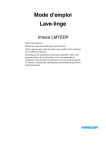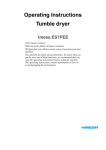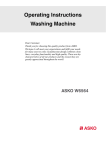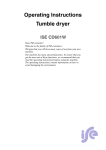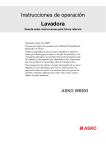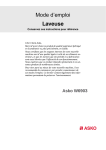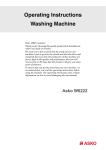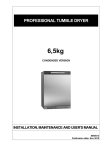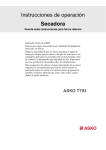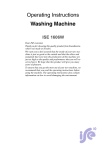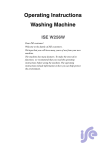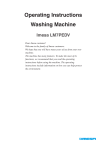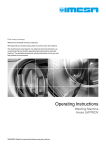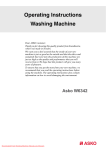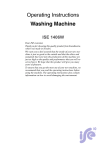Download Operating Instructions Washing Machine
Transcript
Operating Instructions Washing Machine Imesa LM7EDP Dear Imesa customer! Welcome to the family of Imesa customers. We hope that you will have many years of use from your new machine. The machine has many special functions. To ensure that you get the most out of these functions, we recommend that you read the operating instructions before using the machine. The operating instructions contain information on how to avoid damaging the environment. Contents Before using your machine for the first time Transport protection Packing material Washer door Language selection Checking water hardness Safety instructions General Installation Overflow guard function Transport/Winter storage Recycling Child safety Keep an eye on children! Child safety catch Description of the washing machine Detergent compartment Advice and tips before washing Sorting your laundry Clothing Laundry labels Coloured cotton Unbleached linen Wool Rayon fibres and synthetic fibres Detergents Washing Sort your laundry. Turn on the main power switch Open the washer door and load the washing Add detergent and fabric softener, as required Select the programme Close the washer door and press the Start/Stop button Once the program has finished 2 3 3 3 3 3 3 4 4 4 4 4 4 5 5 5 6 6 7 7 7 7 7 7 7 7 7 9 9 9 9 9 10 12 12 Settings You can change the following settings: Door opening Language Temperature Child-safe Care and cleaning Cleaning the trap and the drainage pump Cleaning the detergent compartment Cleaning the outside of the machine Cleaning the inside of the machine to avoid unpleasant smells Rinse holes under the agitator If you have hard water Troubleshooting The washer door will not open The machine will not start Error messages Technical information Technical data Information for test institute Transport protection Installation Positioning the washing machine Adjusting the feet Connection to water supply Drainage connection Electrical installation Service Before contacting the service division Quick guide 13 13 13 13 13 13 14 14 14 14 15 16 16 17 17 17 18 19 19 19 20 21 21 21 21 22 22 23 23 24 Before using your machine for the first time Transport protection Remove any transport protection devices before installing the machine. See the "Transport protection" chapter. Packing material Please sort waste materials in accordance with local guidelines. Washer door • The washer door cannot be opened until the machine is connected to the electricity supply. • To open the door manually, see "The washer door will not open" in the "Troubleshooting" chapter. • The machine cannot be started when the door is open. • To open the washer door while a programme is running, see "Close the door and press the Start/Stop button" in the "Washing" chapter. Language selection You will be prompted to select the display language when you have connected your machine and start it for the first time. Do as follows: Turn the programme selector to choose from: US English, English, Svenska, Dansk, Norsk, Suomi, Français, Deutsch, Italiano, Espanol, Русский, Nederlands. Press the Door opening button or Start/Stop to save and to move on to the clock and time display settings. Checking water hardness The quantity of detergent needed depends, amongst other things, on how hard the water is. See the detergent pack for details. Phone your local water company to check the water hardness in your area. Note! Each machine is tested before leaving the factory. A small amount of water may remain in the drain pump, though this does not affect quality or damage the machine. See Quick guide on the last page 3 Safety instructions General Transport/Winter storage • Read the operating instructions and keep them in a safe place. • Installation of water and electricity, if required, should be carried out by a qualified professional. • The machine should only be used for washing items as described in these instructions. It is not intended for dry cleaning. • Use only detergent intended for machine washing! • Remove any transport protection devices before using the machine. See the "Transport protection" chapter. • Repairs and maintenance relating to safety or performance must be carried out by a qualified professional. • Damaged mains cables must only be replaced by a qualified electrician. • The machine is not designed to be used by persons (even children) that are physically or mentally handicapped or lack experience and knowledge. Such persons must receive instruction in how to use the machine from the person responsible for their safety. • Children must be watched to ensure they do not play with the machine. • In the enclosed plastic bag you will find a tool for opening the washer door in emergencies. If the machine is to be transported or stored in unheated premises where the temperature can fall below freezing, do as follows: • Empty the filter and the drainage pump. See the "Care and cleaning" chapter. • Shut off the water to the washing machine, loosen the supply hose to the intake valve and let the water run out from the valve and hose. • After emptying the pump, a small amount of water may remain in the machine. This does not affect quality or damage the machine. Installation See the "Installation" chapter. Overflow guard function If the machine’s water level rises above the normal level, the overflow guard function begins to pump water out and shuts off the water intake. If the water level has not dropped within 60 seconds, the program is terminated. 4 Recycling This machine is manufactured and labelled for recycling. In order to prevent injuries, the machine must be made unusable once the decision has been taken to dispose of it. Contact your local authority for information about where and how your machine can be recycled correctly. Child safety Keep an eye on children! Child safety catch • Always close the washer door and start the programme immediately after you have added detergent. • Do not allow small children to use or play with the washing machine. • Store detergent and fabric softener out of the reach of children. Do as follows to open the settings menu: 1. Turn off the machine using the main power switch. 2. Press and hold the Door opening button and then press the main power switch. Then press the Door opening button 5 times within 10 seconds. 3. Select the setting you want to change by turning the programme selector. 4. Press the Door opening button once. 5. Change and save the setting as described below. 6. Press Start/Stop to return to the programme menu. You can activate the Child-safe start option to prevent children from starting the machine. 1. Turn the programme selector and select "Child-safe On" or "Child-safe Off". 2. Press the Door opening button once to save the setting. You can temporarily deactivate Child-safe start by pressing Start/Stop and the Door open button at the same time. Child-safe start will be deactivated for 3 minutes. 5 Description of the washing machine 1. 2. 3. 4. 5. 6. 7. Main power switch Detergent compartment Programme panel Type plate (on the inside of the washer door) Drainage pump cover Drainage pump (behind hatch) Washer door 1 2 3 5,6 7 Detergent compartment 1. Pre-wash 2. Main wash 3. Fabric softener 1 6 2 4 3 Advice and tips before washing Here are some tips that may help you before washing. Coloured cotton Sort items according to: • how soiled they are • colour • material Coloured cotton items with the washing instruction 60°C should be washed at 60°C for the first time in order to remove any excess dye. If you do not do so, there is a risk that the colour will run. Use detergent without bleach in order to preserve the colour of the fabric. Clothing Unbleached linen 1. Do up zips and close Velcro straps so that they don’t harm fabrics. 2. New coloured items may contain excess dye and should therefore be washed separately the first few times. 3. Turn delicate items inside out. This reduces the risk of burling and fading. 4. Empty pockets and wash them inside out if possible. Unbleached linen fabrics should be washed at 60°C, using detergent containing no bleach or optical whiteners. Heavily-soiled linen can occasionally be washed at higher temperatures, but not too often because the heat can destroy the linen’s shine and strength. Sorting your laundry Wool These fabrics are labelled either machine wash or hand wash. The Wool/hand wash, 30°C programme is at least as gentle as washing by hand. Rayon fibres and synthetic fibres Materials made of rayon fibres, such as viscose, and some synthetic fibres are very delicate and require much space so as not to crease. Only half fill the drum when washing and choose a spin speed of 800 rpm or lower. Note! Laundry labels Look at the item's laundry label. The table below shows suitable wash programmes for different materials and wash loads. Using modern washing machines and detergents, for example compact detergents, you can usually wash at lower temperatures. It is a good idea to use trial and error to find out what produces the best results. Viscose and acetates are fragile when wet. Detergents Eco-labelled detergents are less harmful to the environment. Detergent overdosing does not give better washing results; it merely causes a greater impact on the environment. Try to use less detergent, and increase only if you are not satisfied with the results. 7 Advice and tips before washing Note! Due to environmental concerns, we discourage the use of strong chemicals. When using agents for bleaching or stain removal, there is a risk of rust (corrosion) and discolouration of the machine. 8 Washing 1 Sort your laundry. Note! See the "Advice and Tips before washing" section. Detergent overdosing does not give better washing results; it merely causes a greater impact on the environment. Place underwired bras in a laundry net. Empty pockets. Coins, nails and the like can cause damage to the machine and fabrics. See the "Advice and Tips" section before washing. 2 3 Turn on the main power switch Open the washer door and load the washing If the washer door is closed, press the Door opening button (key symbol). The door opens once all water has drained from the machine. Load the washing. The wash programme chart shows how much washing can be washed with each programme. Try using less detergent, and increase only if you are not satisfied with the results. Fabric softener Pour the fabric softener into the compartment with the symbol. Follow the recommendations on the fabric softener packaging. Note! Do not fill above the compartment’s maximum fill level. Otherwise fabric softener will run in too early, which impairs the washing effect. 4 Add detergent and fabric softener, as required The detergent packaging will have recommendations for how much detergent you should use. The machine holds 8kg of washing. If you only have a small amount of laundry in the machine, you can reduce the amount of detergent used. Powder detergent Pour the powder into the compartment for the main wash, and pre-wash as well if desired. Liquid detergent When using liquid detergent, follow the detergent manufacturer’s recommendations. We recommend always using a wash ball with very thick liquid detergent. Wash ball or net If you use a wash ball or net, place it directly in the drum and select a programme without pre-wash. 9 Washing 5 Select the programme Programme name Spin Start/Stop 2h Temperature Time The display shows the programme name, the water temperature and the spin speed. The washing machine has a number of preselected programmes when delivered from the factory. The preselected programmes can be replaced. Contact the service division for information on which programmes are available and how to alter the preselected programmes. White, 90°C Programme for normally to heavily soiled laundry. Follow the washing instructions for each garment. 90°C is a good temperature for white and light-coloured cotton, such as bed linen. White/Colour, 60°C Programme for normally soiled laundry, whites and colours. Follow the washing instructions for each garment. 60°C is a good temperature for garments worn next to the skin. White/Colour, 40°C Programme for normally soiled laundry, whites and colours. Follow the washing instructions for each garment. 10 Door opening Super quick wash, 60°C Fast programme for laundry that just needs freshening up. Follow the washing instructions for each garment. Garments worn next to the skin ought to be washed at 60°C. Super quick wash, 40°C Fast programme for laundry that just needs freshening up. Follow the washing instructions for each garment. Synthetics, 40°C Programme for synthetics, delicate blended materials and permanent press cotton. Suitable for shirts and blouses. Follow the washing instructions for each garment. Many synthetics will come clean at 40°C. Wool/hand wash, 30°C A gentle laundry programme for wool, silk and garments that should be washed by hand. This programme has a short spin. Rinse This programme performs one cold rinse cycle + spin. Suitable for laundry that just needs to be dampened. Washing Programme chart Program Water consump- Energy consump- Programme time Pre(approx. hrs and Number Spin Speed Max. load tion tion wash Temp. °C of Rinses rpm (kg) (approx. liter) (approx. kWh) min.) White, 90°C 90 3 1200 8 50 1,3 0:60 White/Colour, 60°C 60 3 1200 8 45 0,3 0:50 White/Colour, 40°C 40 3 1200 8 50 0,3 0:50 Super quick wash, 60°C 60 3 800 4.0 35 0,6 0:30 Super quick wash, 40°C 40 3 800 4.0 35 0,3 0:25 Synthetics, 40°C 40 3 800 4.0 40 0,3 0:25 Wool/hand wash, 30°C 30 3 800 2.7 60 0,3 0:30 1 1200 4.0 20 0,1 0:15 Rinse Information for test institute The above table presents a few examples of the energy, water and time consumption of a few different programme settings. Consumption can vary depending on water pressure, water hardness, water supply temperature, room temperature, load weight and content, variations in the power supply and selected options. 11 Washing 6 7 "Programme started" is shown on the display. The washer door opens automatically once the programme has finished. If you want to deactivate the automatic door opening function, see the "Selecting settings" section. • Remove the load. • Turn off the main power switch, this will save energy. Close the washer door and press the Start/Stop button Time remaining The time remaining is shown in hours and minutes. Once a programme is selected, the estimated programme time is displayed. This may differ from time to time depending on the temperature of the water entering the machine and the size of the load. If the programme time is longer than the previous wash with the same programme, "0:01" will be displayed until the programme finishes. This is normal! To add or remove washing after the program starts If you want to add or remove items after the programme has started, you can stop the programme by pressing and holding the Door opening button (key symbol) for three seconds. When you restart the machine, add any extra detergent needed and close the washer door. The machine continues automatically from the point where the programme was interrupted. Stopping or changing a programme You can stop a programme by pressing the Start/Stop button for three seconds. "Stop" appears in the display. To restart the machine, select a new programme, add any extra detergent needed and press the Start/Stop button. Note! Do not open the detergent compartment while the machine is running. 12 Once the program has finished Once a programme has finished, "End" appears on the display. If you have small children or pets at home, close the washer door once you have removed the laundry. Backlighting Two minutes after the wash programme finishes the display backlighting enters energy saving mode. Settings You can change the following settings: • • • • Language Child-safe Door opening Temperature °C/°F Do as follows to open the settings menu: 1. Turn off the machine using the main power switch. 2. Press and hold the Door opening button and then press the main power switch. Then press the Door opening button 5 times within 10 seconds. 3. Select the setting you want to change by turning the programme selector. 4. Press the Door opening button once. 5. Change and save the setting as described below. 6. Press Start/Stop to return to the programme menu. Door opening If you do not want the washer door to open automatically when the programme is finished you can deactivate this function. 1. Turn the programme selector, choose "Automatic door opening on" or "Automatic door opening off". 2. Press the Door opening button once to save the setting. Language 1. Turn the programme selector to choose from: US English, English, Svenska, Dansk, Norsk, Suomi, Français, Deutsch, Italiano, Espanol, Русский, Nederlands. 2. Press the Door opening button once to save the setting. Temperature 1. Turn the programme selector to choose between: °C and °F. 2. Press the Door opening button once to save the setting. Child-safe You can activate the Child-safe start option to prevent children from starting the machine. 1. Turn the programme selector and select "Child-safe On" or "Child-safe Off". 2. Press the Door opening button once to save the setting. You can temporarily deactivate Child-safe start by pressing Start/Stop and the Door open button at the same time. Child-safe start will be deactivated for 3 minutes. 13 Care and cleaning Cleaning the trap and the drainage pump The washing machine has a trap where smaller objects such as coins and hairpins can collect. To clean the trap and the drainage pump, do as follows: 1. Make sure the machine is empty of water and switched off at the mains. Cleaning the detergent compartment Note! Do not run the detergent compartment through a dishwasher! Pull the detergent compartment out as far as it will go. 2. Open the door. Lift the detergent compartment upwards and then outwards to remove it from the machine. 3. Unhook the drainage hose from the connector inside the door and drain the water into a suitable container, such as a bowl. 4. Turn the cover anti-clockwise to open the pump. Remove the cover. Rinse the compartment and scrub it clean. The fabric softener compartment cover can be removed. Cleaning the outside of the machine 5. Remove any items and so forth from the pump housing and the cover. Also check that the pump blades right at the back rotate. 6. Screw on the cover, replace the drainage hose on the hatch pin and close the hatch. 14 Clean the outside of the machine and the program panel with a mild cleaner. Do not use any solvents, as these can damage the machine. Note! Do not hose down the machine with water! Care and cleaning Cleaning the inside of the machine to avoid unpleasant smells Modern detergents often allow clothes to be washed at low temperatures. This means that small deposits can build up in the machine. These, in turn, may lead to unpleasant smells developing. To avoid this, we recommend running a 95°C wash programme once a month. When you do this, use a small quantity of detergent. It is not necessary to put any washing in the machine. 15 Care and cleaning Rinse holes under the agitator If you have hard water If you suspect that objects such as nails or paper clips may have fallen into the wash drum, you should check the space under the agitator. Such objects can rust and cause spots on clothing. Nails and other sharp objects can cause holes in fabrics. If you live in an area with hard water (high limescale content), a greyish-white coating may form on the wash drum. To remove this coating, empty about 20gram of citric acid into the wash drum and run any 95°C programme. Repeat if necessary. Do as follows: 1. Insert a screwdriver or the like into the hole on the agitator as illustrated and carefully pry to the left. 2. Use your other hand to grasp the agitator and pull it towards you. 3. Lift the agitator. 4. Remove any objects. 5. Place the agitator in the mounting hole with the F-mark towards you. Ensure that all the agitator fasteners are in their holes in the drum. Push it in until it catches. 16 Troubleshooting The washer door will not open 1. Check that the main power switch is on. 2. Is there power? Check your home’s fuses (circuit breakers). The washer door cannot be opened with the door opening button (with the key symbol) if power is off. If nothing else works, the washer door can be opened as follows: If in the future the washer door does not open when the wash programme has finished, call the service division. The machine will not start 1. Is the washer door properly closed? Push it firmly. 2. Is there power? Check your home’s fuses. Caution! The door may only be opened manually if the electric power is cut and the machine has been drained of water. A First empty the water from the washing machine. Press and hold the Door opening button for three seconds to pump out the water. If this does not work the machine must be drained manually. See "Cleaning the trap and the drainage pump" in the "Care and cleaning" chapter. B Ensure that the main power switch is turned off and that the plug has been removed from the wall socket. C Take the emergency door opening tool and place it in the gap on the right side of the washer door lock. This tool is found in the enclosed plastic bag. D Push the tool upwards to open the washer door. 17 Troubleshooting Error messages If an error occurs during the programme a message is shown on the display. To exit the message after taking measures, turn the machine off and then back on. Water inlet fault Check: The error messages that may be shown in the display are: • that the tap on the water pipe is open. • that the filter in the machine’s water intake is not blocked. Close the door Action: Close the washer door and the programme will start. Overfilling 1. Shut off the water tap. 2. See "Drainage error". Drainage error Check: • that no objects are stuck in the drainage hose outlet. • that the drainage pump is not blocked by foreign objects. Clean the pump. See the "Care and cleaning" chapter. • that there are no kinks in the drainage hose. Press the Door opening button (key symbol) to empty the machine of water before opening the 18 washer door. If this does not resolve the problem, call the service division. 1. Shut off the water tap. 2. Unscrew the hose. 3. Clean the filter in the intake valve on the machine. 4. Screw the hose back on. 5. Turn on the tap. 6. Run the program again to check if the fault is fixed. 7. If this does not resolve the problem, call the service division. Door opening error Call the service division! Motor fault Call the service division! Technical information Technical data Height: Width: Depth: Weight: Cylinder volume: Max. washing capacity: Spin speed (rpm): Rated power: Heater output: Water pressure: 850mm 595mm 585mm 73kg 60l 8kg 400-1200 See type plate. See type plate. 0,1-1 MPa 2 1-10 kp/cm 2 10-100 N/cm Wash drum and liquid compartment material: Outer casing material: Water connection: Drain: Stainless steel Powder-coated and hot-galvanized sheet steel or stainless steel. 1.5m pex pipe 1.7m polypropylene hose 3/4 BSP connection This machine is approved for all UK applications as suitable for Category 5. Product is listed in the WRAS regulations advisory scheme directory and is suitable for direct connection to mains drinking water. No special plumbing arangements e.g. break tanks are required. Information for test institute Energy declaration European test standard: Washing program: Connection: Test method for noise measurement: EN 60456 Normal, 60°C, 1600 rpm, 8kg cotton Cold water 15°C IEC-60704-2-4 Power requirement when machine turned off Power requirement for Delayed Start Power requirement when programme finished < 0,3 W < 6,0 W < 3,0 W 19 Transport protection Before the machine is used, the three transport screws should be removed as shown below. Note! If the machine is to be moved and transported, the transport screws must be refitted to prevent damage to the machine through shaking. If the transport screws or plastic plugs have been lost you can order new ones from your retailer. Article number 80 882 77 80 884 67 Designation Screw Plastic plug Order three of each item! 1. Loosen and remove the screws. 2. The enclosed plastic bag contains three plastic plugs to fit in the empty screw holes. 20 Installation Positioning the washing machine The washing machine can be installed as a built-in or freestanding unit. Position the machine so that the electrical plug is easily accessible. A. Built-in The washing machine can be installed under a counter top with a working height of 850-900 mm. Leave a 5 mm space around the entire machine, including between the rear edge of the top cover and the wall behind it. B. Freestanding The washing machine can be positioned beside or under a tumble dryer. Adjusting the feet Keep the noise that the machine produces to a minimum by adjusting the feet so that the machine is steady and balanced on the floor. Tighten the lock nuts. Locking nut Use only the supply hose supplied with the machine. Do not re-use old hoses or other loose supply hoses. Water intake At the factory, the machine is set to take in a mixture of hot and cold water. The machine can be set for cold water intake only. This setting must be made by a qualified professional. Contact the service division. Should the machine need to be well secured to the floor, anti-tilt devices, with fitting instructions, are shipped with the machine. Connection to water supply Water connection should be carried out by an appropriately qualified person. Connect the machine using the accompanying supply hose. Water pressure should be 0.1–1MPa (approx. 2 2 1–10kp/cm ; 10–100N/cm ). There should be a stopcock on the water pipe. If the pipes are newly installed, it may be wise to flush them through so that any dirt is washed away. Otherwise, dirt can clog the filter in the machine’s water intake and cut off the water supply. 21 Installation Drainage connection Electrical installation The machine is supplied with a drainage hose attached, which must be connected to a drain. See the examples below. The height must be 600-900 mm above floor level. The electrical connection must be made using a cable for permanent installation, with a multipolar circuit breaker, by a qualified professional. The lower position (600 mm) is always preferable. Ensure that the drainage hose has no kinks. The machine is supplied as 3-Phase, 400V, 50-60Hz, heat output 3000W and has a 10A plug. Any residual current devices must be type A. Connection on delivery Note! Repairs and maintenance relating to safety or performance must be carried out by a qualified professional. 600-900mm Coin operation The machine is prepared for coin operation. Such installation must be carried out by a qualified professional. The machine can also be connected to the drain via a spigot connection. In this case the hose should also be 600-900 mm above the floor. The internal diameter of the hole should be at least 18 mm. • Cut the nipple • Remove burrs from the hole. See the illustration. The installation requires a connection cable to power the coin meter. This connection cable can be ordered as an accessory using the factory art. no. 92 090 95. The coin meter must be able to short circuit two signal lines for periods of up to 10 minutes. This is to give the user time to load the machine, choose a programme and start the programme after inserting the coins. "Insert coin" appears on the display when the machine is started with the main power switch. At least 18 mm 22 Service Before contacting the service division Model designation Before you contact the service division, make sure that you know the model designation, type designation and serial number. The model designation can be found on the panel. The type designation and serial number can be found on the type plate on the inside of the washer door. Type plate Type designation 70.C2 Serial number (12 digits) 23 Quick guide Washing 1 1. Empty pockets and refasten zips. 2. Read the item’s laundry label. 3. Sorting laundry. Note! Place underwired bras in a laundry net. Load the laundry 2 1. Press the main power switch. 2. If the washer door is closed, press the Door opening button (key symbol) and the door will open. 3. Load the washing and close the washer door. Detergent compartment 3 1. Pour detergent into the main wash compartment, and pre-wash compartment as well if required. Pour fabric softener into the compartment on the right with the -symbol. 2. If you use liquid detergent, follow the detergent manufacturer’s recommendations. Select the programme 4 5 1. Select a programme by turning the programme selector. 2. Press the Start/Stop button. Program finished 1. "End" on the display indicates that the wash programme has finished. 2. The washer door opens automatically once the programme has finished. 3. Remove the load. 4. Turn off the main power switch. If you have small children or pets at home, close the washer door once you have removed the laundry. Art. No.: 80 900 53. Rev. 01. We reserve the right to make changes. Printed on environmentally friendly paper that meets the requirements of MIljöförbundet and Naturskyddsföreningen. 24

























